Horizontal Polarized DC Grounded Omnidirectional Antenna for UAV Ground Control Station
Abstract
1. Introduction
2. Antenna
3. Feed Mechanism
4. Simulation Verification
5. Antenna Fabrication and Measurement Result
6. Comparison
7. Conclusions
Author Contributions
Funding
Institutional Review Board Statement
Informed Consent Statement
Data Availability Statement
Conflicts of Interest
References
- Sevgi, L. The Antenna as a Transducer: Simple Circuit and Electromagnetic Models. IEEE Antennas Propag. Mag. 2007, 49, 211–218. [Google Scholar] [CrossRef]
- Sadiq, M.S.; Ruan, C.; Nawaz, H.; Abbasi, M.A.B.; Nikolaou, S. Mutual Coupling Reduction between Finite Spaced Planar Antenna Elements Using Modified Ground Structure. Electronics 2021, 10, 19. [Google Scholar] [CrossRef]
- Niaz, M.W.; Sadiq, M.S.; Yin, Y.; Zheng, S.; Chen, J. Reduced aperture low sidelobe patch array. Electron. Lett. 2018, 54, 800–802. [Google Scholar] [CrossRef]
- Cui, Y.; Luo, P.; Gong, Q.; Li, R. A Compact Tri-Band Horizontally Polarized Omnidirectional Antenna for UAV Applications. IEEE Antennas Wirel. Propag. Lett. 2019, 18, 601–605. [Google Scholar] [CrossRef]
- Nawaz, H.; Liang, X.; Sadiq, M.S.; Abbasi, M.A.B. Ruggedized Surface-Mount Omnidirectional Antenna for Supersonic Aerial Platforms. IEEE Antennas Wirel. Propag. Lett. 2020, 19, 1439–1442. [Google Scholar] [CrossRef]
- Nawaz, H.; Liang, X.; Sadiq, M.S.; Geng, J.; Jin, R. Circularly-Polarized Shaped Pattern Planar Antenna for Aerial Platforms. IEEE Access 2020, 8, 7466–7472. [Google Scholar] [CrossRef]
- Nawaz, H.; Liang, X.; Sadiq, M.S.; Geng, J.; Zhu, W.; Jin, R. Ruggedized Planar Monopole Antenna With a Null-Filled Shaped Beam. IEEE Antennas Wirel. Propag. Lett. 2018, 17, 933–936. [Google Scholar] [CrossRef]
- Choi, Y.-S.; Park, J.-S.; Lee, W.-S. Beam-Reconfigurable Multi-Antenna System with Beam-Combining Technology for UAV-to-Everything Communications. Electronics 2020, 9, 980. [Google Scholar] [CrossRef]
- Lee, C.U.; Noh, G.; Ahn, B.; Yu, J.-W.; Lee, H.L. Tilted-Beam Switched Array Antenna for UAV Mounted Radar Applications with 360° Coverage. Electronics 2019, 8, 1240. [Google Scholar] [CrossRef]
- Kim, K.; Yoo, J.; Kim, J.; Kim, S.; Yu, J.; Lee, H.L. All-Around Beam Switched Antenna With Dual Polarization for Drone Communications. IEEE Trans. Antennas Propag. 2020, 68, 4930–4934. [Google Scholar]
- Sun, L.; Li, Y.; Zhang, Z.; Feng, Z. Compact Co-Horizontally Polarized Full-Duplex Antenna with Omnidirectional Patterns. IEEE Antennas Wirel. Propag. Lett. 2019, 18, 1154–1158. [Google Scholar] [CrossRef]
- Liu, Y.; Li, X.; Yang, L.; Liu, Y. A Dual-polarized Dual-band Antenna with Omni-directional Radiation Patterns. IEEE Trans. Antennas Propag. 2017, 65, 4259–4262. [Google Scholar] [CrossRef]
- SJun, Y.; Shastri, A.; Sanz-Izquierdo, B.; Bird, D.; McClelland, A. Investigation of Antennas Integrated into Disposable Unmanned Aerial Vehicles. IEEE Trans. Veh. Tech. 2019, 68, 604–612. [Google Scholar]
- Echeveste, J.I.; de Aza, M.A.G.; Zapata, J. Shaped beam synthesis of real antenna arrays via finite-element method Floquet modal analysis and convex programming. IEEE Trans. Antennas Propag. 2016, 64, 1279–1286. [Google Scholar] [CrossRef]
- Manoochehri, O.; Darvazehban, A.; Salari, M.A.; Khaledian, S.; Erricolo, D.; Smida, B. A dual-polarized biconical antenna for direction finding applications from 2 to 18 GHz. Microw. Opt. Technol. Lett. 2018, 60, 1552–1558. [Google Scholar] [CrossRef]
- Chen, Z.N.; Liu, D.; Nakano, H.; Qing, X.; Zwick, T. (Eds.) Handbook of Antenna Technologies; Springer: Singapore, 2016. [Google Scholar]
- Lin, C.; Kuo, L.C.; Chuang, H.R. A horizontally polarized omnidirectional printed antenna for WLAN applications. IEEE Trans. Antennas Propag. 2006, 54, 3551–3556. [Google Scholar] [CrossRef]
- Wei, K.; Zhang, Z.; Feng, Z. Design of a wideband horizontally polarized omnidirectional printed loop antenna. IEEE Antennas Wirel. Propag. Lett. 2012, 11, 49–52. [Google Scholar]
- Wei, K.; Zhang, Z.; Feng, Z.; Iskander, M.F. An MNG-TL loop antenna array with horizontally polarized omnidirectional patterns. IEEE Trans. Antennas Propag. 2012, 60, 2702–2710. [Google Scholar] [CrossRef]
- Kajfez, D.; Elsherbeni, A.Z.; Demir, V.; Hasse, R. Omnidirectional square loop segmented antenna. IEEE Antennas Wirel. Propag. Lett. 2016, 15, 846–849. [Google Scholar] [CrossRef]
- Quan, X.; Li, R. A broadband dual-polarized omnidirectional antenna for base stations. IEEE Trans. Antennas Propag. 2013, 61, 943–947. [Google Scholar] [CrossRef]
- Fan, Y.; Liu, X.; Liu, B.; Li, R. A broadband dual-polarized omnidirectional antenna based on orthogonal dipoles. IEEE Antennas Wirel. Propag. Lett. 2016, 15, 1257–1260. [Google Scholar] [CrossRef]
- Dai, X.-W.; Wang, Z.-Y.; Liang, C.-H.; Chen, X.; Wang, L.-T. Multiband and dual-polarized omnidirectional antenna for 2G/3G/LTE application. IEEE Antennas Wirel. Propag. Lett. 2013, 12, 1492–1495. [Google Scholar] [CrossRef]
- Yu, Y.; Jolani, F.; Chen, Z. A wideband omnidirectional horizontally polarized antenna for 4G LTE applications. IEEE Antennas Wirel. Propag. Lett. 2013, 12, 686–689. [Google Scholar] [CrossRef]
- Cai, X.; Sarabandi, K. A Compact Broadband Horizontally Polarized Omnidirectional Antenna Using Planar Folded Dipole Elements. IEEE Trans. Antennas Propag. 2016, 64, 414–422. [Google Scholar] [CrossRef]
- LYe, H.; Zhang, Y.; Zhang, X.Y.; Xue, Q. Broadband Horizontally Polarized Omnidirectional Antenna Array for Base-Station Applications. IEEE Trans. Antennas Propag. 2019, 67, 2792–2797. [Google Scholar]
- Sangster, A.J.; Wang, H. Moment method analysis of a horizontally polarised omnidirectional slot array antenna. IEEE Proc. Microw. Antennas Propag. 1995, 142, 1–6. [Google Scholar] [CrossRef]
- Iigusa, K.; Tanaka, M. A horizontally polarized slot-array antenna on a coaxial cylinder. In Proceedings of the 2000 Asia-Pacific Microwave Conference. Proceedings (Cat. No.00TH8522), Sydney, Australia, 3–6 December 2000; pp. 1444–1447. [Google Scholar]
- Zhou, B.; Geng, J.; Bai, X.; Duan, L.; Liang, X.; Jin, R. An Omnidirectional Circularly Polarized Slot Array Antenna with High Gain in a Wide Bandwidth. IEEE Antennas Wirel. Propag. Lett. 2015, 14, 666–669. [Google Scholar] [CrossRef]
- Sadiq, M.S.; Ruan, C.; Nawaz, H.; Ullah, S.; He, W. Low Gain Ripple and DC-Grounded Slant-Polarized Formulation With 360° Broadbeam Coverage. IEEE Access 2020, 8, 224190–224199. [Google Scholar] [CrossRef]
- Balanis, C.A. Antenna Theory: Analysis and Design; Wiley-Interscience: Hoboken, NJ, USA, 2005. [Google Scholar]
- Costa, A.; Goncalves, R.; Pinho, P.; Carvalho, N.B. Design of UAV and ground station antennas for communications link budget improvement. In Proceedings of the 2017 IEEE International Symposium on Antennas and Propagation & USNC/URSI National Radio Science Meeting, San Diego, CA, USA, 9–14 July 2017; pp. 2627–2628. [Google Scholar]
- Quan, X.L.; Li, R.-L.; Wang, J.Y.; Cui, Y.H. Development of a Broadband Horizontally Polarized Omnidirectional Planar Antenna and its Array for Base Stations. Prog. Electromagn. Res. 2012, 128, 441–456. [Google Scholar] [CrossRef]
- Daly, R. Development of Omnidirectional Collinear Arrays with Beam Stability for Base Station and Mobile Applications. Master’s Thesis, RMIT University, Melbourne, Australia, 2013. [Google Scholar]
- Fujita, K. MNL-FDTD/SPICE method for fast analysis of short-gap ESD in complex systems. IEEE Trans. Electromagn. Compat. 2016, 58, 709–720. [Google Scholar] [CrossRef]
- Ohmine, H.; Sunahara, Y.; Sato, S.; Katagi, T.; Wadaka, S. Omnidirectional Slot Antenna. U.S. Patent 5,717,410, 10 February 1998. [Google Scholar]
- Pozar, D.M. Microwave and RF Design of Wireless Systems, 1st ed.; Wiley Publishing: Hoboken, NJ, USA, 2000. [Google Scholar]


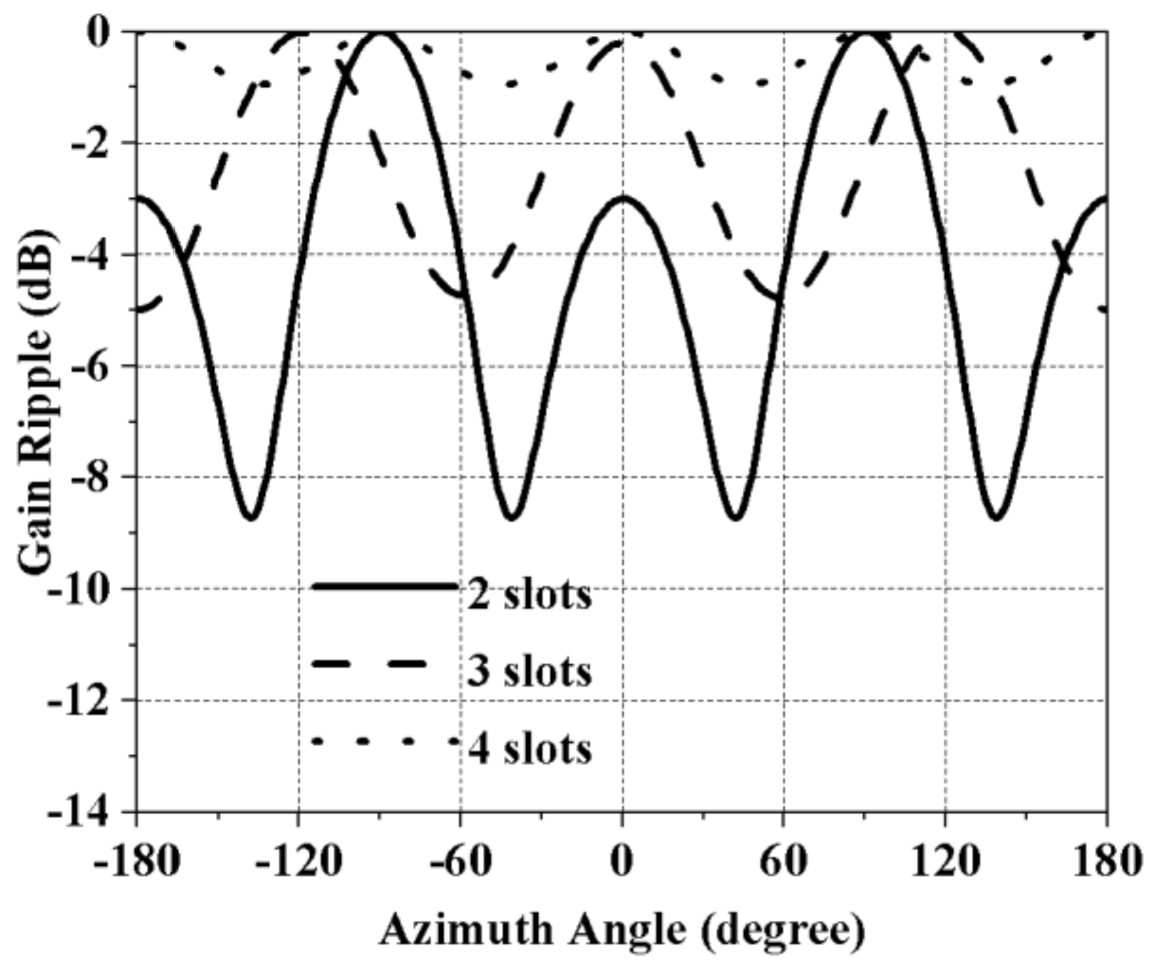

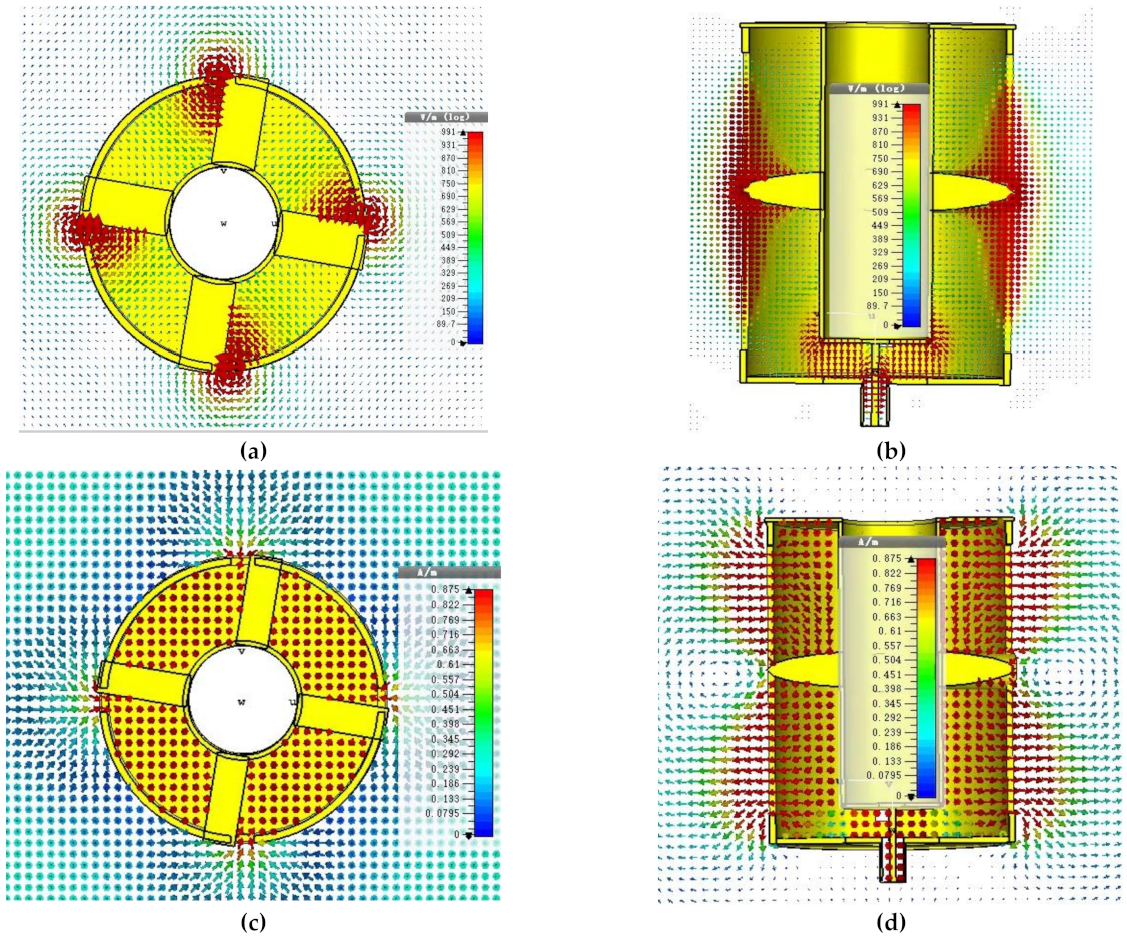
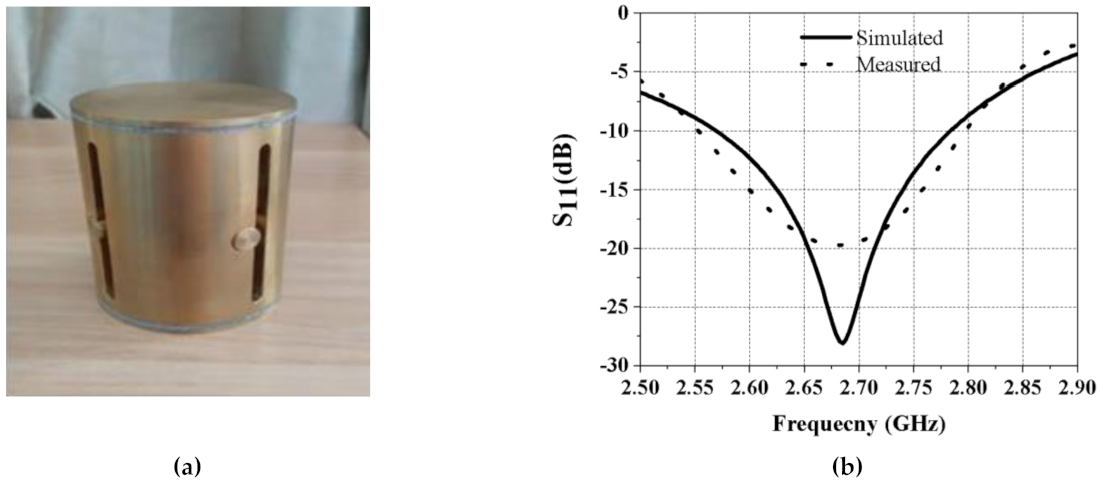
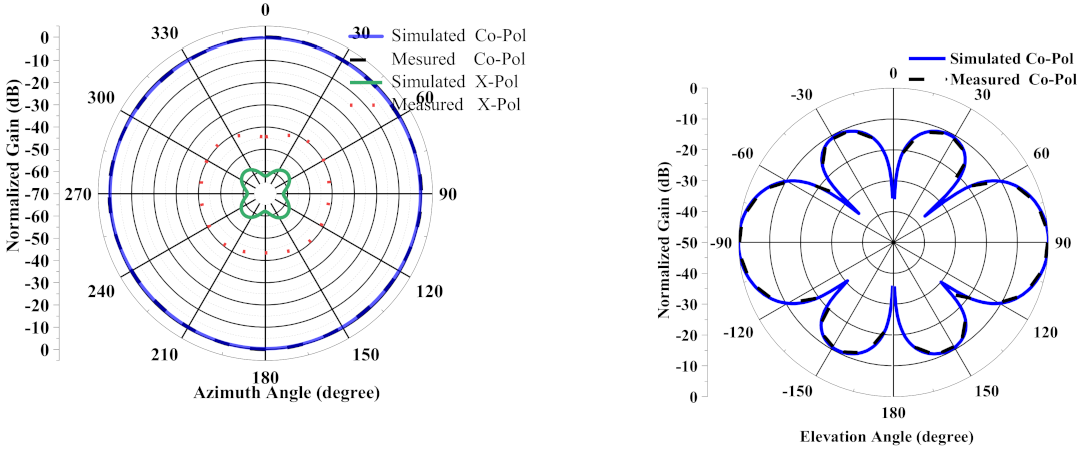
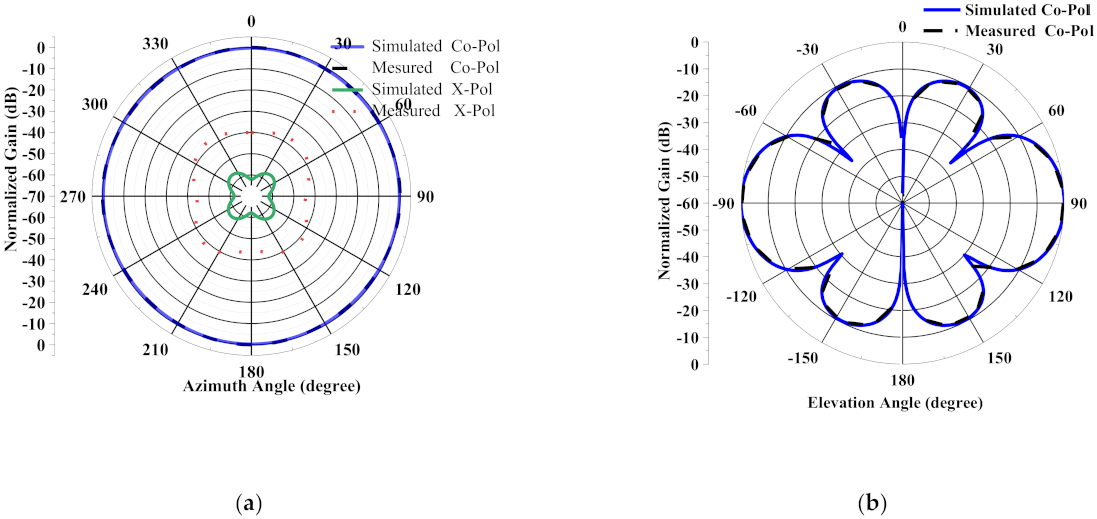

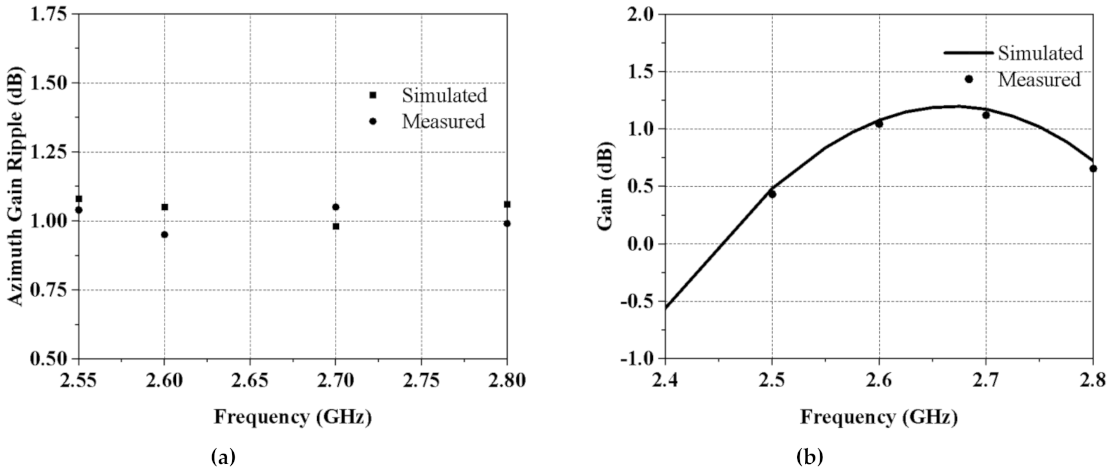
| Parameter | Value (mm) |
|---|---|
| Outer Cylinder Diameter A | 60 |
| Inner Cylinder Diameter B | 25 |
| Slot feed Pin Diameter P | 10 |
| Antenna Height H | 75 |
| Slot Length L | 65 |
| Slot Width W | 5 |
| SMA Pin Height T | 7.25 |
| Reference | Polarization Purity | Gain Ripple (dB) | DC Ground | Feed Type |
|---|---|---|---|---|
| [17] | 11 | ±5.5 | No | Exposed |
| [18] | 20 | NA | No | Exposed |
| [19] | 20 | 1.3 | No | Exposed |
| [20] | 25 | 1.0 | No | Exposed |
| [21] | 18 | 1.5 | No | Exposed |
| [22] | 20 | 1.5 | No | Exposed |
| [23] | 15 | 1.5 | No | Exposed |
| [24] | 15 | NA | No | Exposed |
| [25] | 20 | 2.0 | No | Exposed |
| [26] | 20 | 2.1 | No | Exposed |
| Proposed work | 40 | ±0.5 | Yes | Enclosed |
Publisher’s Note: MDPI stays neutral with regard to jurisdictional claims in published maps and institutional affiliations. |
© 2021 by the authors. Licensee MDPI, Basel, Switzerland. This article is an open access article distributed under the terms and conditions of the Creative Commons Attribution (CC BY) license (https://creativecommons.org/licenses/by/4.0/).
Share and Cite
Sadiq, M.S.; Ruan, C.; Nawaz, H.; Ullah, S.; He, W. Horizontal Polarized DC Grounded Omnidirectional Antenna for UAV Ground Control Station. Sensors 2021, 21, 2763. https://doi.org/10.3390/s21082763
Sadiq MS, Ruan C, Nawaz H, Ullah S, He W. Horizontal Polarized DC Grounded Omnidirectional Antenna for UAV Ground Control Station. Sensors. 2021; 21(8):2763. https://doi.org/10.3390/s21082763
Chicago/Turabian StyleSadiq, Muhammad Shahzad, Cunjun Ruan, Hamza Nawaz, Shahid Ullah, and Wenlong He. 2021. "Horizontal Polarized DC Grounded Omnidirectional Antenna for UAV Ground Control Station" Sensors 21, no. 8: 2763. https://doi.org/10.3390/s21082763
APA StyleSadiq, M. S., Ruan, C., Nawaz, H., Ullah, S., & He, W. (2021). Horizontal Polarized DC Grounded Omnidirectional Antenna for UAV Ground Control Station. Sensors, 21(8), 2763. https://doi.org/10.3390/s21082763







